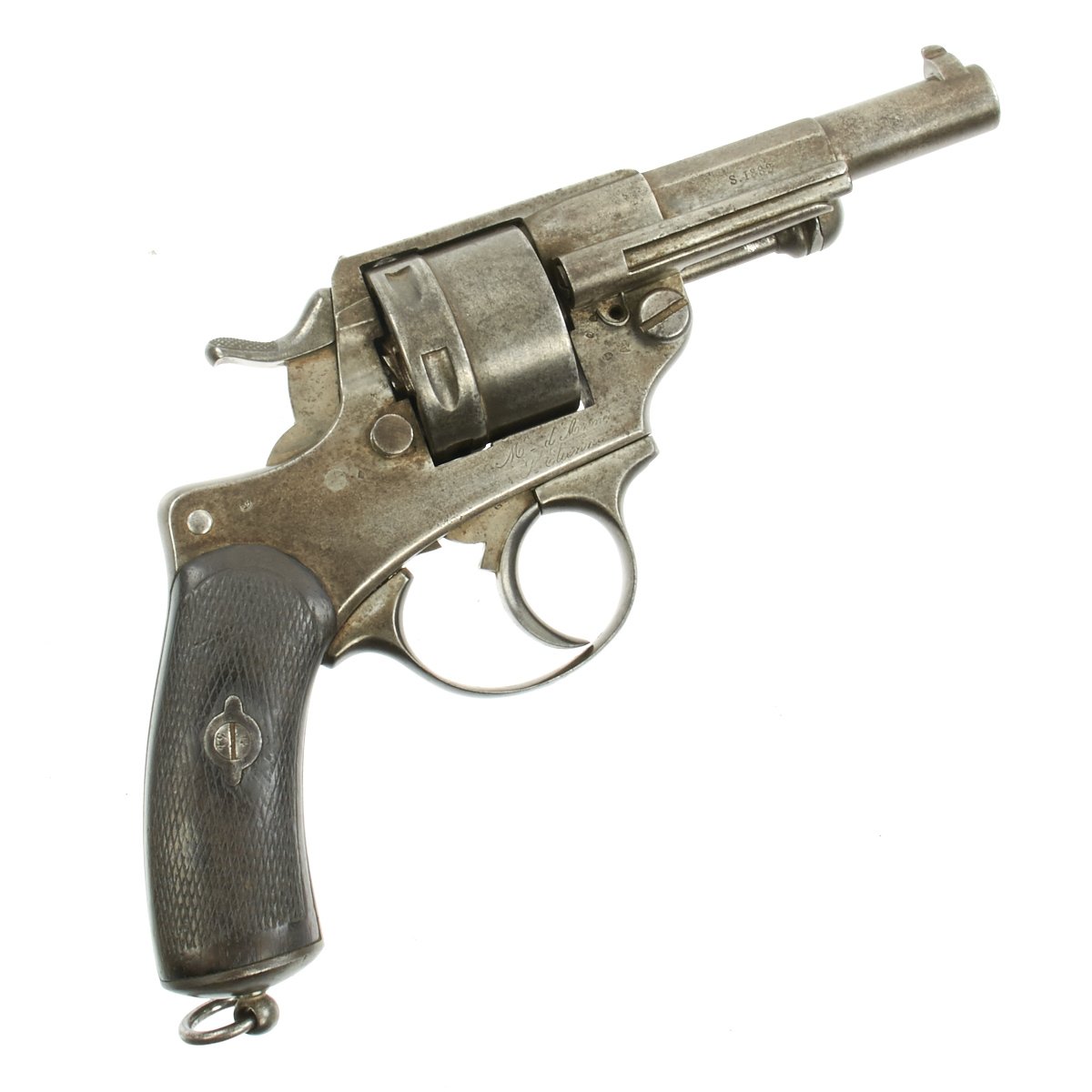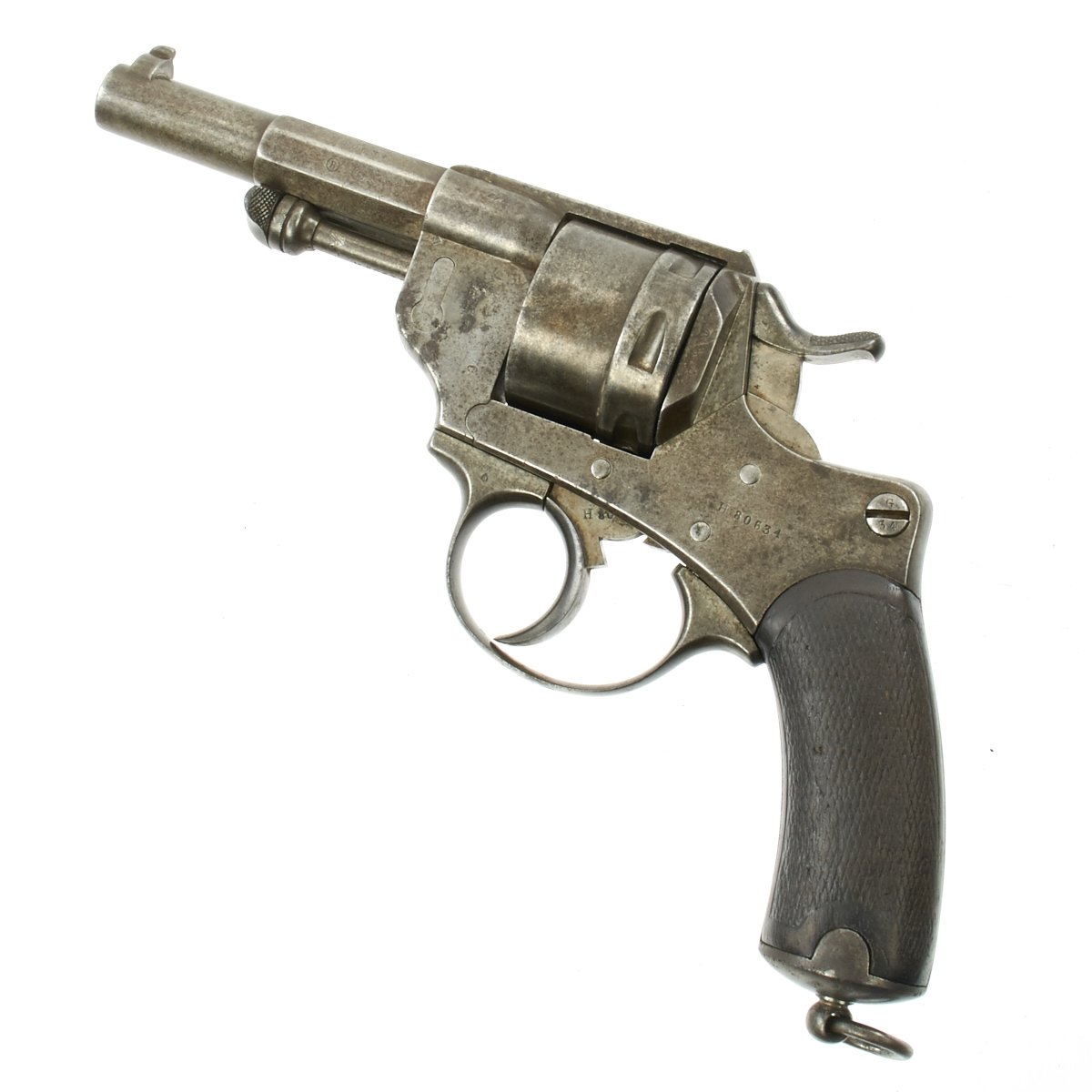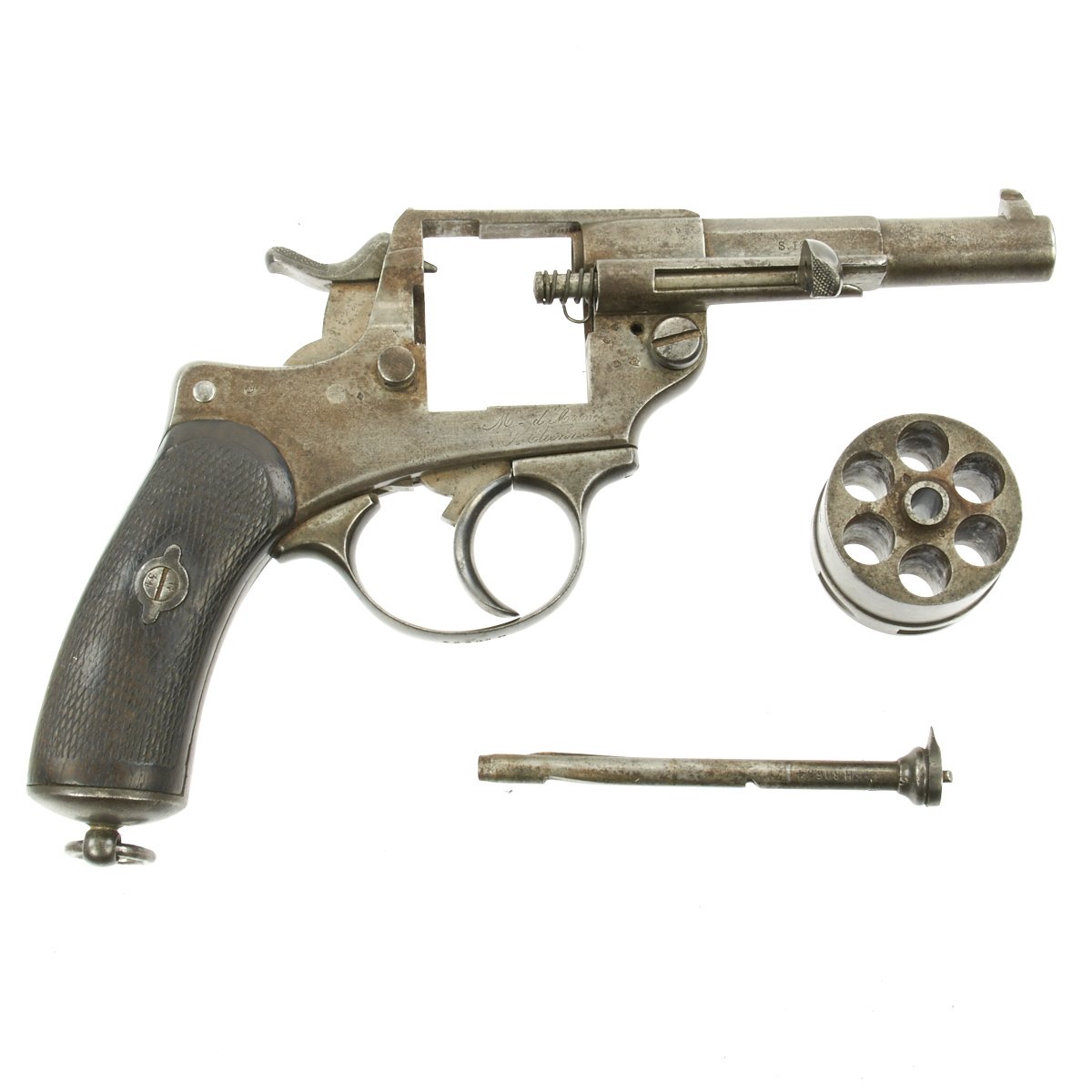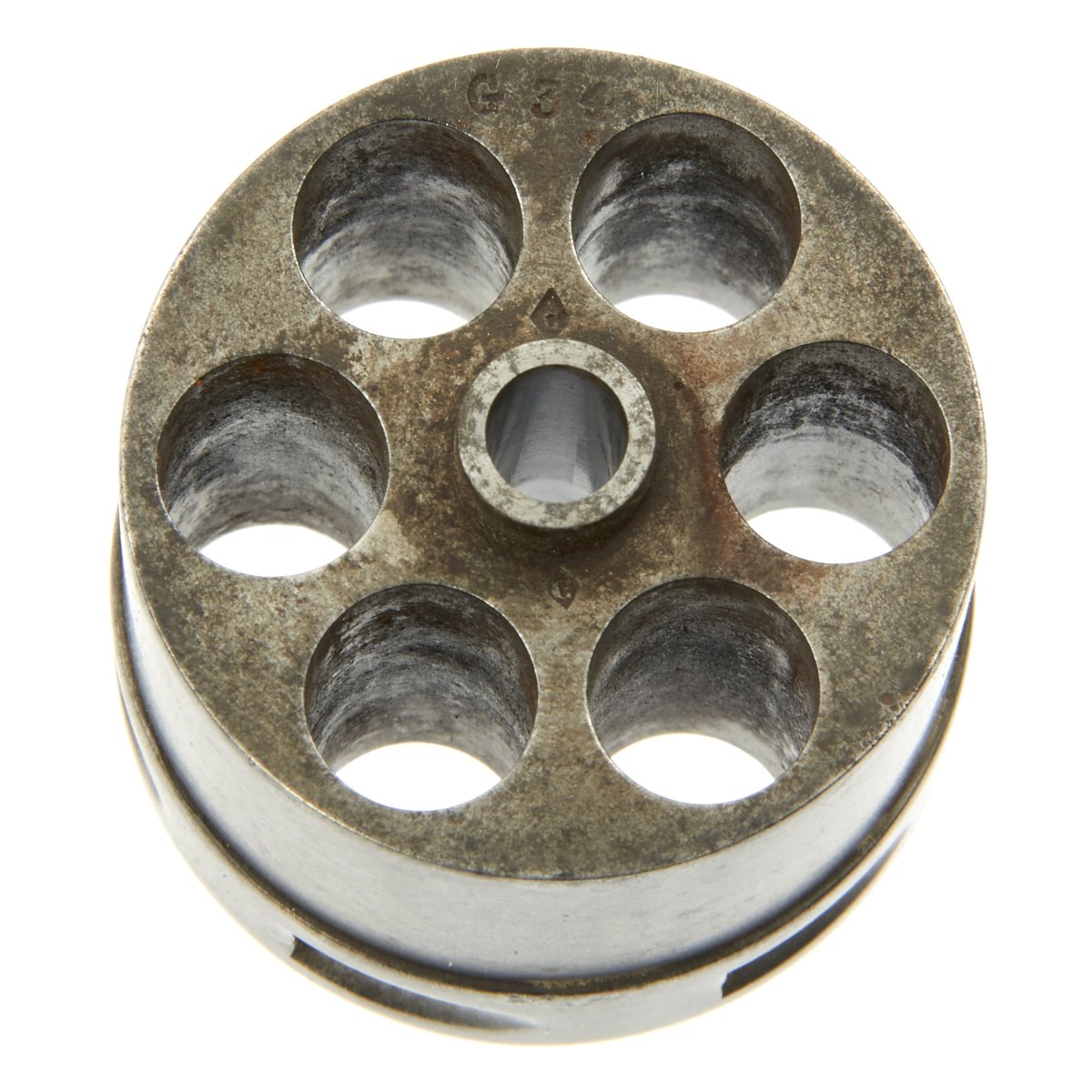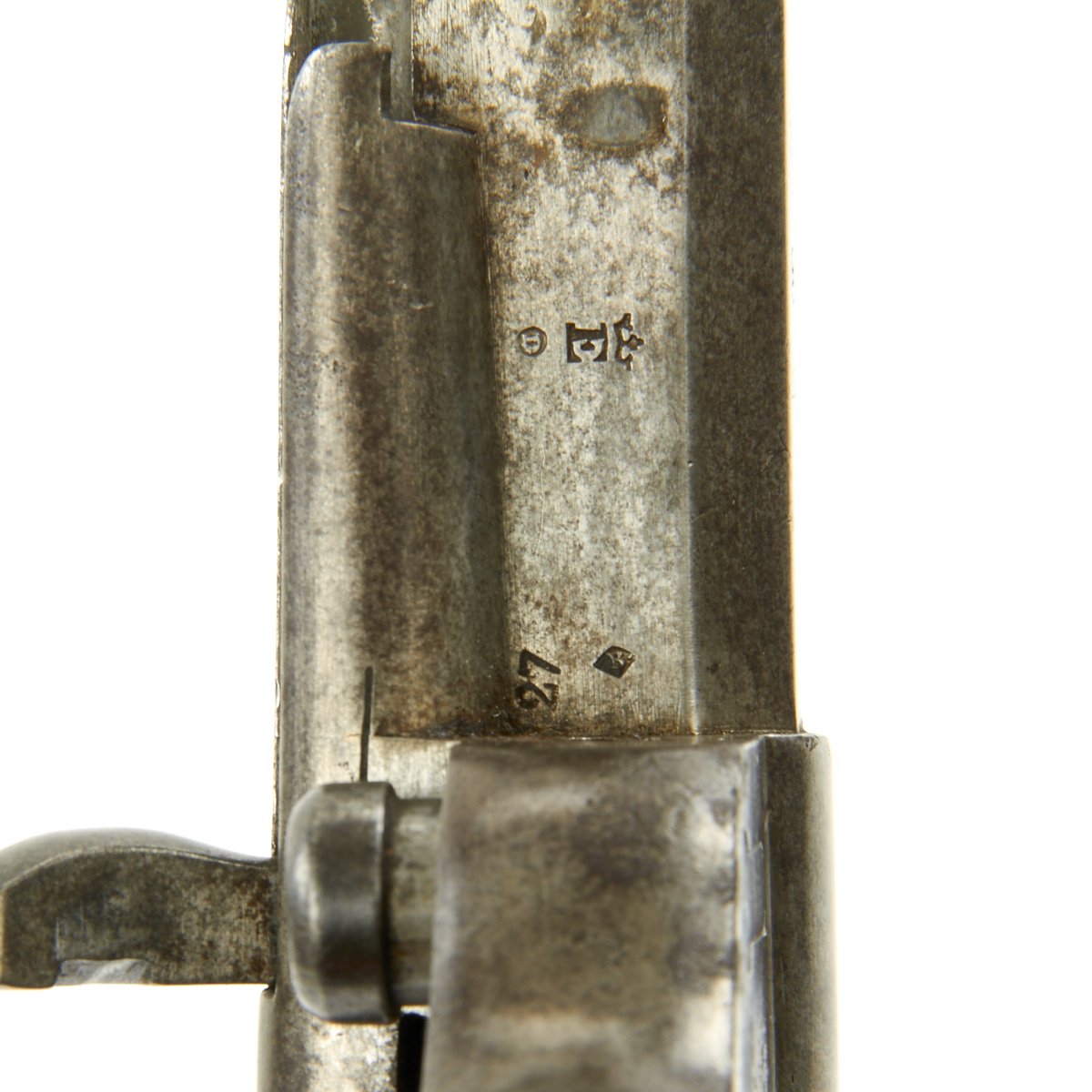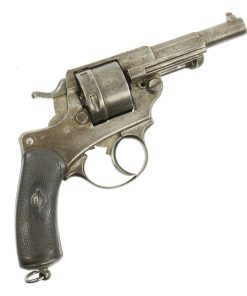Original French MAS Modèle 1873 11mm Revolver Dated 1882 – Serial Number H80634 Original Items
$ 995,00 $ 248,75
Original Item: Only One Available. This is a wonderful condition example of the service revolver model 1873 Chamelot-Delvigne which was the first double-action revolver used by the French Army. It was produced by Manufacture d’armes de Saint-Étienne from 1873 to 1887. Although replaced by the Modele 1892 revolver, it was nevertheless widely used during the First World War, and issued to reserve units in 1940. The Resistance made widespread use of it during the Occupation. Both the 1873 and the 1874 use a 11mm cartridge which proved to have an insufficient velocity. The weapons themselves were very reliable and resistant.
This excellent mechanically sound example is in the original bright finish, though it does have some staining and light pitting due to over 100 years of age. It is marked Mre d’Armes / Saint-Étienne on the right side of the frame and features all matching serial number H80634 on the barrel, frame, trigger guard, cylinder, trigger, hammer, and cylinder axis pin. The top of the barrel is marked Mle 1873 and the side of the barrel is marked S. 1882, indicating the revolver was manufactured in 1882. Many of the small parts of the revolver are also marked with assembly number G/34.
The checkered wooden grips are original and the overall condition of the revolver is very good. Finish is still mostly bright steel, with some staining from age, and a bit of past pitting. Barrel is in good condition, with clear lands and grooves and a bright finish. The lanyard ring is still present, and is not damaged or dented. Interestingly, the loading gate on the right side of the cylinder’s rear has been removed to facilitate quick re-loading, often a real necessity when fighting the Arab Rebels in the North African Desert. Also, the small screw holding the ejector spring in place was removed long ago.
You may recall that a pair of these revolvers were carried in shoulder holsters by Brendan Fraser in his 1999 adventure film “THE MUMMY”.
A great chance to own a nice example of a late 19th century French Service Revolver, ready to display.
History of the MAS 1873
The Franco-Prussian War in 1870 clearly demonstrated the need for up-to-date equipment in war time. A great military tradition and esprit de corps can be defeated by superior training, and in the case of that war, artillery. After the war, both Germany and France continued to improve their military technology. However, neither side was convinced of the importance of pistols for field officers. The sword continued to be the symbol of authority for an officer on the battlefield all the way into World War I. European general staffs at that time were extremely conservative and pistols were sometimes grudgingly adopted as personal defense weapons with no practical offensive use. Even as pistols became more of a symbol of the officer, most preferred to privately purchase a smaller and more comfortable handgun instead of using a large standard issue revolver.
The Chamelot-Delvigne 11mm Modele 1873 was adopted by the French army as a service revolver for non-commissioned officers. The Modele 1874 Revolver d’Officier was the version issued to officers. The differences between the two models included the following: the 1873 was finished in the white, whereas the 1874 had a fluted cylinder and a blued finish. The 1873 and 1874 were the first center-fire cartridge revolvers adopted by the French army. They had solid-frame, side-ejection, double-action mechanisms. The pistols were manufactured by the St. Etienne armoury, which still continues to manufacture fine sporting arms.
The design of the Chamelot-Delvigne revolvers became so popular that versions were adopted by the Belgian in 1871, Dutch, Italian, and 1872 in Switzerland with the Model 1872 Revolver.
The caliber of these French pistols was 11×17.8mmR. The French round was actually 0.47 mm larger than its German counterpart. The German round could be loaded and used in the French pistol, but French rounds would not chamber in the German pistol. The cartridge had a pointed lead bullet weighing 11 grams. The case length was 17.8 mm, which was rather on the short side. Reloading this cartridge could take some patience due to the shortness of the case. Military specifications called for black powder loads, replaced by a mild smokeless powder in the early twentieth century. Standard muzzle velocity was around 550 feet per second.
The cylinder had a side-loading gate which pulled straight to the rear. The sight picture was a ball and v type and is easy to align. It could be difficult to stay on target double-action due to the stiffness of the action. There was certainly no danger of accidentally pulling the trigger double-action. Cleaning and disassembly were easy as the cylinder pin doubled as a screwdriver and all-purpose tool. Internal parts were finely machined and finished. The trigger, hammer, and several of the internal springs were straw-finished, a type of case-hardening hot oil finish.
The French pistols began their service with the French army in the late 19th Century and saw service all over the globe in French colonies. Many saw service in World War I when European armies finally realized how important pistols were in the trenches. The Chamelot-Delvigne finally ended its venerable service as a police sidearm in World War II.
Specifications of MAS model 73
Year of Manufacture: 1882
Length: 240 mm (9.5 inches)
Barrel length: 115 mm (4.5 inches)
Finish: Bright Steel
Weight (empty): 1.04 kg
Cylinder: 6 cartridges
Ammunition: 11 mm Mle 1873 (11x17mmR)
Rifling: 4 right-hand grooves
Operation: Double Action / Single Action
NOTE: International orders of antique firearms MUST be shipped using UPS WW Services (courier). USPS Priority Mail international will not accept these.
Fast Shipping with Professional Packaging
Thanks to our longstanding association with UPS FedEx DHL, and other major international carriers, we are able to provide a range of shipping options. Our warehouse staff is expertly trained and will wrap your products according to our exact and precise specifications. Prior to shipping, your goods will be thoroughly examined and securely secured. We ship to thousands clients each day across multiple countries. This shows how we're dedicated to be the largest retailer on the internet. Warehouses and distribution centres can be located throughout Europe as well as the USA.
Note: Orders with more than one item will be assigned a processing date depending on the item.
Before shipping before shipping, we'll conduct a thorough inspection of the items you have ordered. Today, the majority of orders will be delivered within 48 hours. The delivery time will be between 3-7 days.
Returns
The stock is dynamic and we cannot completely manage it because multiple stakeholders are involved, including our factory and warehouse. So the actual stock may alter at any time. It's possible that you may not receive your order once the order has been made.
Our policy is valid for a period of 30 days. If you don't receive the product within 30 days, we are not able to issue a refund or an exchange.
You can only return an item if it is unused and in the same state as the day you received it. You must have the item in its original packaging.
Related products
Uncategorized
Uncategorized
Uncategorized
Uncategorized
Uncategorized
Uncategorized
Uncategorized
Uncategorized
Uncategorized
Uncategorized
Armored Burgonet Helmet & Polearm from Scottish Castle Leith Hall Circa 1700 Original Items
Uncategorized
Armoured Fighting Vehicles of the World: AFVs of World War One (Hardcover Book) New Made Items
Uncategorized
Uncategorized
Band of Brothers ORIGINAL GERMAN WWII Le. F.H. 18 10.5cm ARTILLERY PIECE Original Items
Uncategorized
Angolan Rebel 1970s era 60mm Inert Display Mortar from Angolan Civil War Original Items
Uncategorized
Uncategorized
Uncategorized
Uncategorized
Uncategorized
